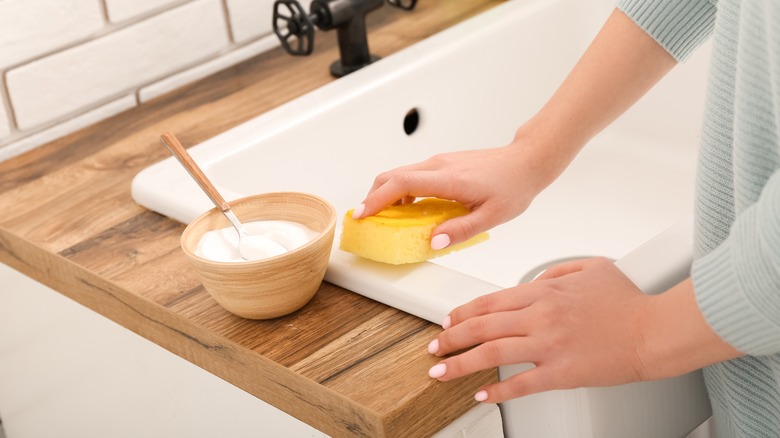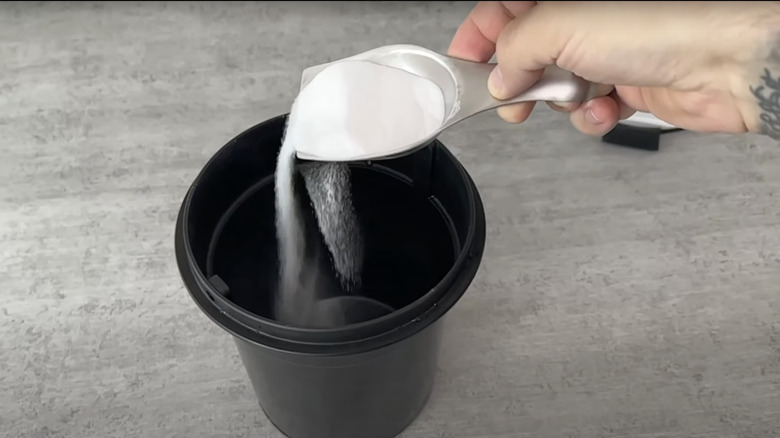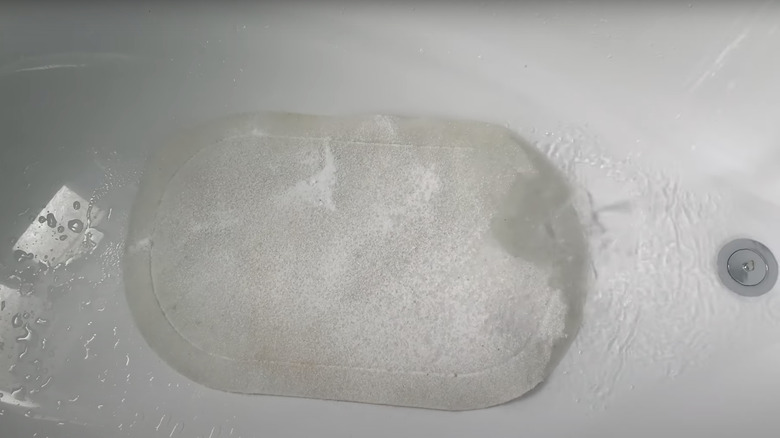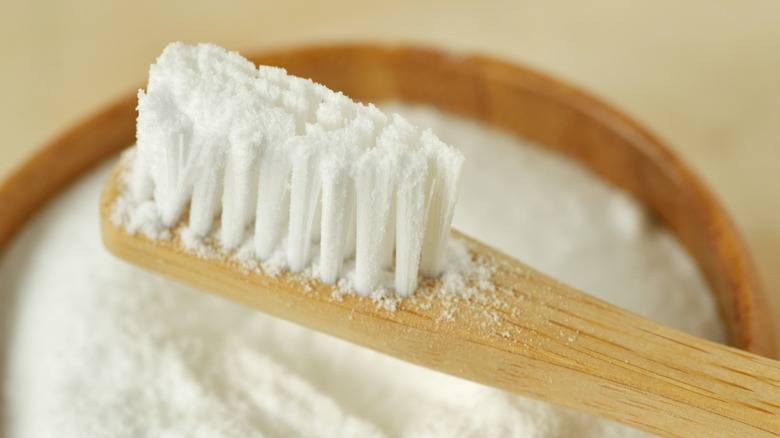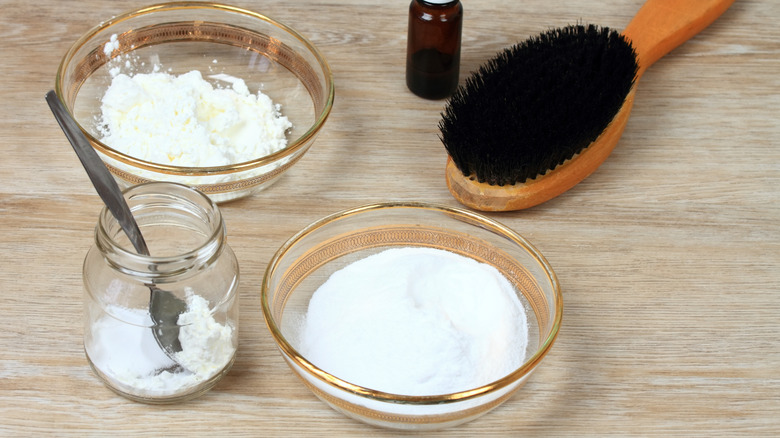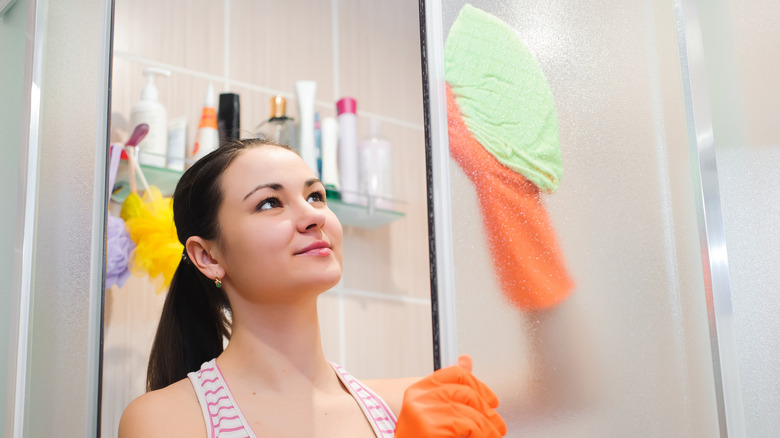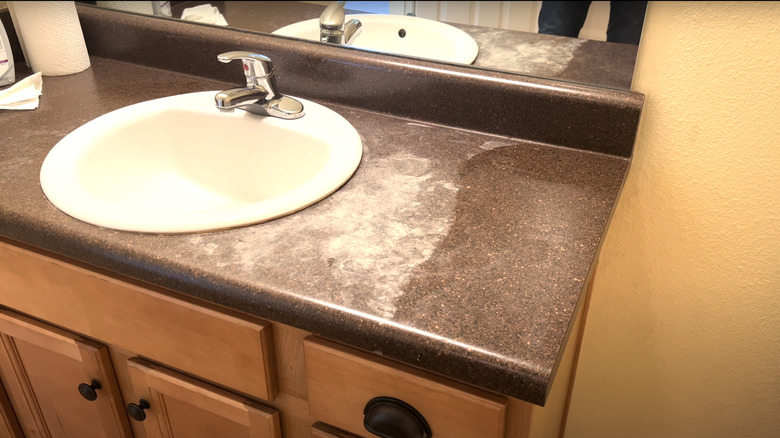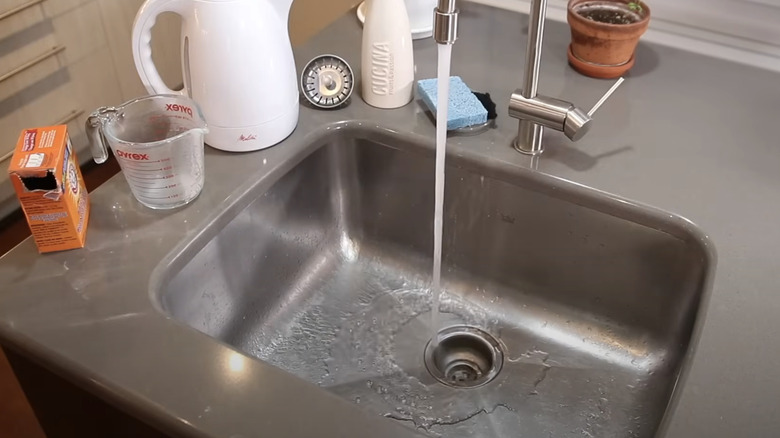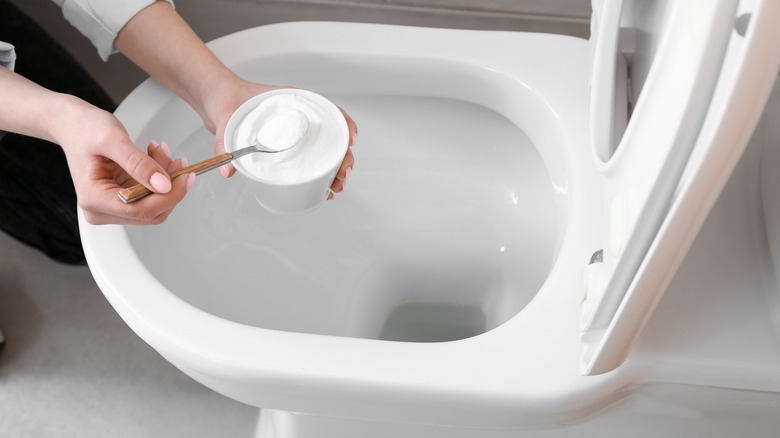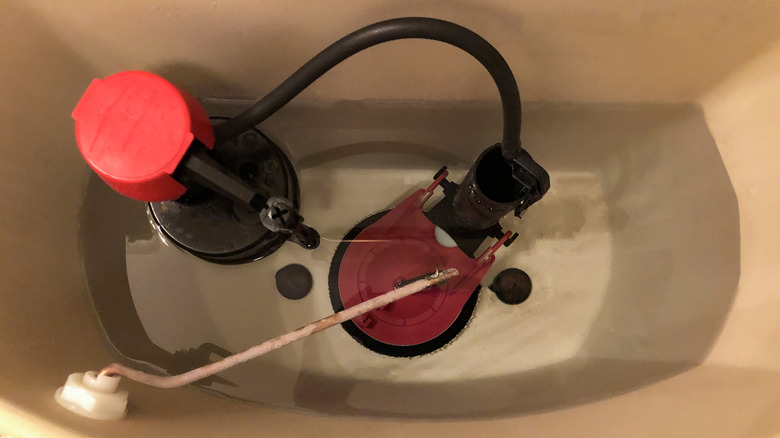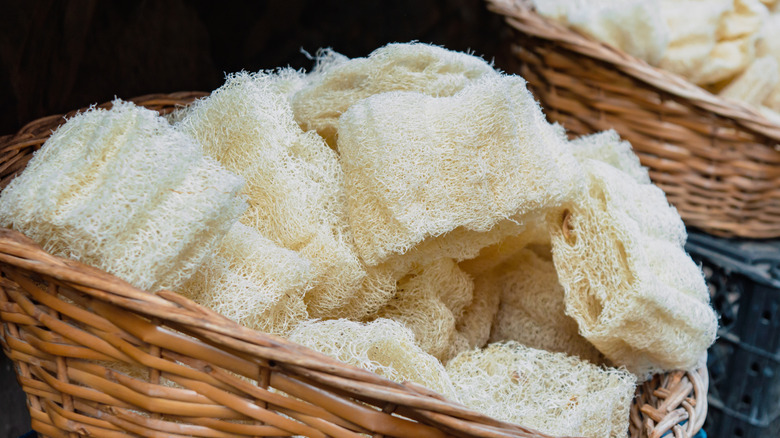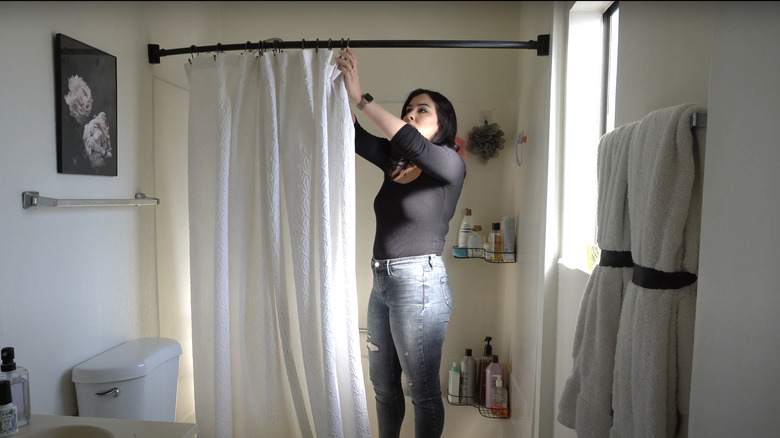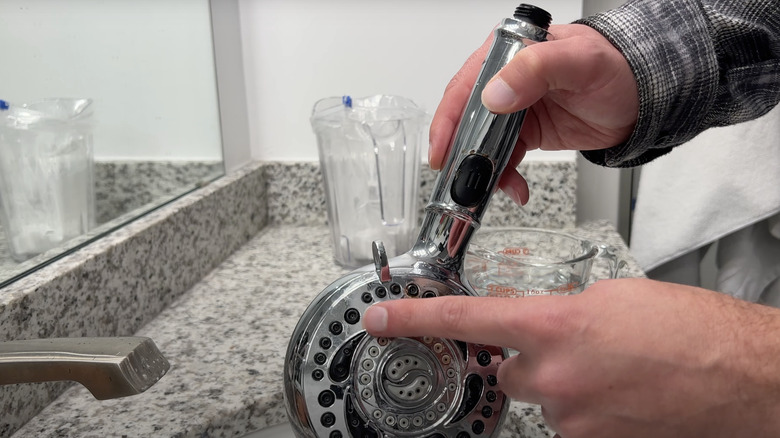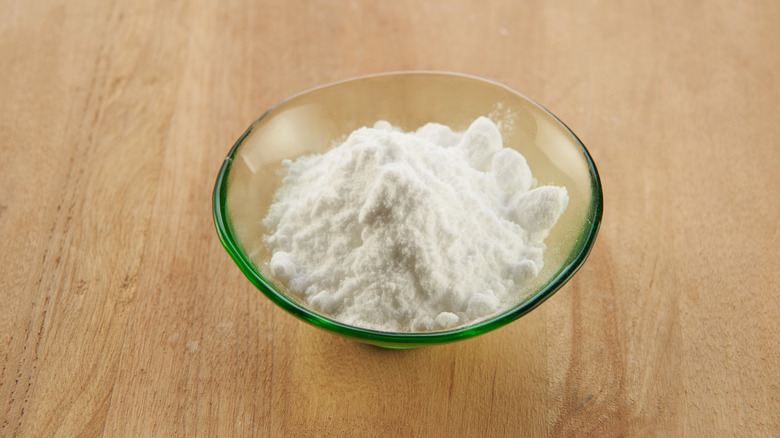13 Clever Uses For Baking Soda In The Bathroom
Sodium bicarbonate, better known as baking soda, is an indisputable household essential. It's a simple crystalline powder made of carbon, hydrogen, oxygen, and sodium and is usable in various cleaning ventures. This compound is especially useful in bathrooms where cleanliness and fragrances are a priority.
Bathrooms are prone to mold and grime buildup due to their plumbing fixtures and moist environment. Showers, sinks, and toilets cause humid, water-ridden conditions ripe for bacteria growth and general dirtiness. Fortunately, you can use baking soda, which is an alkaline compound with a mid-high pH level, to cleanse various surfaces, appliances, and decorative accents. It's nontoxic and doesn't risk staining or destroying most materials.
Below are thirteen ways to use sodium bicarbonate to clean and freshen nearly every bathroom feature. All it takes is some water, a few cleaning cloths, and an occasional splash of vinegar to disinfect your private quarters. Read more below to learn how to boost your quality of life using this simple ingredient.
Soak up smells in your trash can
Unpleasant smells can sometimes linger in your trash can, even after throwing out your garbage and changing the liner. Toss a half cup of baking soda into the bottom of the can and let it sit for about ten minutes. Use a sponge, towel, or cleaning brush and warm water to scrub the inside clean. Add dish soap for fragrance and to break down stubborn buildup. Once finished, rinse the can in your sink, bathtub, or outside with a hose. Air-dry the can or wipe away the water with a towel; the garbage odor should be gone.
This process works because baking soda is an alkaline mineral with a 9 pH level. The high pH neutralizes the acids that cause unwanted odors. Therefore, when you mix it with the acidic grime in trash cans, the interaction removes the horrendous smells. Remember to clean your garbage can as needed in the future
Deodorize and freshen bathroom rugs
In addition to deodorizing trash cans, baking soda can work the same magic on your bathroom rugs. These mats are especially vulnerable to smelling musty due to constant exposure to dripping water and high humidity. Before sprinkling baking soda over the entire carpet, test an inconspicuous corner to ensure it doesn't discolor anything. If you don't see any staining, sprinkle the powder lightly over the dry rug. Let it sit for about fifteen minutes before vacuuming up the baking soda. The powder should have absorbed the mildewy smells, leaving your rug refreshed and stink-free.
The smells should disappear when the baking soda pH mixes with the smelly acids to make a non-fragrant reaction. The increased pH also hampers bacteria growth, making your rugs more hygienic. If you want to completely disinfect your rugs, mix the baking soda with vinegar, and scrub the fabric by hand or throw it in the wash.
Create your own toothpaste
Save money and boost your oral health with homemade toothpaste made of sodium bicarbonate. Mix a teaspoon of baking soda and water together to create a tiny amount of paste for your toothbrush. Dip your brush into the well-mixed paste and use it to scrub your teeth. Spit out the baking soda mixture like you would with normal toothpaste for whitened and plaque-free teeth.
Baking soda is mildly abrasive, so it works well for this purpose. The gritty powder gently lifts plaque, stains, and sticky food remnants from teeth. It is a common ingredient in toothpaste, and some people prefer sodium bicarbonate over fluoride, another toothpaste mineral. Toothpaste and mouthwash with significant amounts of fluoride shouldn't be swallowed for health reasons. In households with children and people with sensitivities, baking soda toothpaste is actually a more practical alternative to keep these individuals from accidentally consuming fluoride.
Occasionally use it as a DIY shampoo and exfoliant
All-natural products are on the rise, and many seek hair treatments devoid of additives like sulfates, parabens, and phthalates. The best way to avoid accidentally using exfoliants and shampoos with these ingredients is by creating a DIY formula with baking soda. Baking soda removes greasy and oily buildup from hair as it does on rugs and other household surfaces. When used in moderation, like on a weekly basis, it removes dry skin and deep cleans your hair.
Aim to mix one part baking soda with three parts water. About three tablespoons of baking soda and one-half cup of water should suffice for short hair. Depending on your total hair length and thickness, you may need to add more as you go. Apply the mixture like you would normal shampoo, but also use apple cider vinegar to rinse and replenish your hair's natural pH level.
Keep in mind that you should avoid overusing baking soda for this purpose. Sodium bicarbonate shampoo doesn't work for everyone, as everyone's skin and hair reacts differently to new ingredients. It strips hair of natural oils, which may leave it too dry if you have a drier scalp. The small crystals in baking powder may also contribute to split ends if you have dyed or bleached hair since these processes also strip moisture from hair.
Scrub grimy glass shower doors
Glass shower doors have become increasingly popular over the years due to their sleek appearance and easy upkeep. Even though they're easy to maintain, it's not entirely effortless, and baking soda comes in handy. Mix a half-cup of baking soda and add water until you get a thick paste. Put the paste on a microfiber cloth and gently rub away mold, mildew, and calcium deposits from your glass shower doors. Rinse by running the showerhead to remove all of the baking soda.
You can also use your homemade paste of a half-cup of baking soda and water to scrub your countertops. Wear latex gloves and gently smooth the paste over your entire bathroom countertop. Let it sit for about ten minutes to ensure it has time to soak in the smells and grime before softly wiping it off with a microfiber cloth. Rinse off the last pieces of grit using warm water and another cleaning cloth.
This trick is most effective on oil-based stains since the baking soda absorbs the oil as it sits. You can apply it to granite, marble, laminate, and stainless steel as long as the surfaces are properly sealed. Remember, baking soda is abrasive, which is how it scrubs countertops clean and removes stains. Be gentle as you rub to avoid accidentally damaging your surfaces.
The baking soda breaks down buildup with its tiny crystal-like consistency, gently scraping off the hardened spots. If your shower is made of glass and ceramic or porcelain tile, add vinegar to the paste to improve its effectiveness. Just remember vinegar is highly acidic and scratches and discolors stones and travertine materials, so you should avoid using it anywhere near these products.
Create a countertop cleaner paste
You can also use your homemade paste of evenly mixed baking soda and water to scrub your countertops. Mix a half-cup of each together in a bowl and set it on your counter. Wear rubber or latex gloves and gently smooth the paste over your entire bathroom countertop. Let it sit for about ten minutes to ensure it has time to soak in the smells and grime before softly wiping it off with a microfiber cloth. Rinse off the last pieces of grit using warm water and another cleaning cloth.
This trick is most effective on oil-based stains since the baking soda absorbs the oil as it sits. You can apply it to granite, marble, laminate, and stainless steel as long as the surfaces are properly sealed. Remember, baking soda is abrasive, which is how it scrubs countertops clean and removes stains. It's only as gentle as your hand motions, so use soft motions to avoid accidentally damaging your surfaces.
Prevent stinky drains
Bathroom sinks, showers, and bathtubs drains give off an odor when clogged with old hair, soap, toothpaste, and other cosmetic and hygienic products. If you can't unstick your drain with a plumbing snake (also known as a drain snake) or a hot water flush, you can use baking soda and vinegar to help break up the mass. Pour one cup of baking soda and two cups of vinegar down your drain and wait thirty minutes. Flush it away with hot water from your faucet; the smell and clog should disappear.
The low pH of vinegar interacts with the high pH of baking soda and causes a bubbling chemical reaction. The bubbles break up the clogged debris into smaller pieces that can now run down the pipes when you flush water through them. These two ingredients also neutralize the odors emitted by the buildup, eliminating those as well.
Unclog toilets
In addition to clearing drain buildup, baking soda and vinegar also work to unclog toilets. Start by ensuring the water level isn't too high– the chemical reaction of baking soda and vinegar foams up and could overflow if you don't lower the water to a halfway point. Slowly pour one cup of baking soda and one cup of vinegar into the toilet bowl, and stop if the fizz bubbles start rising too high and too quickly. Let the concoction sit for about 20 minutes before flushing the toilet.
This process breaks down toilet clogs the same way it affects sink and bathtub clogs. The conflicting acid and base solutions cause a chemical reaction that breaks up the obstruction so waste can again flow freely through your plumbing pipes. If the first time around doesn't work, you may need to let the solution sit overnight or assist the mixture with determined plunging.
Clean out toilet tanks
Cleaning toilet tanks isn't a part of regular chore routines, but it should be done around twice a year. Take off the top lid of the tank and set it gently on the ground before you begin. Shut off the water valve and flush your toilet to empty the tank. Once it's completely empty, combine one-half cup of baking soda, two tablespoons of dishwashing soap, and a whole cup of vinegar. Use a toilet brush to scrub the mixture around the inside of the tank until you eliminate most of the residue.
Abrasive baking soda and acidic vinegar are an unstoppable duo for cleaning the grimiest places in your household, such as this unpleasant location. The baking soda breaks down buildup while the vinegar helps wipe away what's left. Dish soap isn't necessary, but it also contributes to breaking down residue the same way it removes food and oil from dinnerware and cookware.
Soak and sanitize bath sponges
Many people mistakenly believe that bath sponges and loofahs get washed with you when you shower, but they need cleaning outside of bathing sessions. Put the sponge in a cup of water with one tablespoon of baking soda for 15 minutes. Rinse it thoroughly, preferably with hot water, and let it air dry before using it again. Repeat the process weekly or as needed.
Baking soda is ideal for this purpose because it dissolves organic compounds like dirt and dead skin. It's also gentle and nontoxic, so you don't have to worry about it getting on your skin later on. Avoid adding harsh cleansers with bleach or chlorine. Since you use the loofah to scrub your body, you don't want any of those residual chemicals touching your bare skin. Instead, add tea tree oil or vinegar to this cleaning regimen to perform deeper cleanings and ensure you remove as much bacteria as possible.
Remove mold from fabric and vinyl shower curtains
Daily showers or baths lead to inevitable mold and mildew on your shower curtains. Luckily, fabric and plastic curtains and liners require the same upkeep. If washing each piece individually, toss it in the washing machine with a few teaspoons of baking soda. If you're washing them with other garments, use a half-cup for the full laundry load.
When mold and mildew are concentrated in certain areas, you may not have to wash the whole thing. Take down your curtain or liner and make a paste using equal parts warm water and baking soda. Scrub the cloth or vinyl with a soft microfiber cloth until all the offending buildup is removed.
The baking soda is abrasive, which helps remove the sticky growth. Add vinegar to increase its effectiveness, but be careful – the acidic qualities may stain fabric if you apply it directly. You should test a discreet corner of the curtain and dilute the acid with equal parts water before incorporating it into your endeavor.
Polish stainless steel fixtures
You don't need a specialized formula to remove rust and corrosion on stainless steel fixtures. Create a thick paste of baking soda and water, identical to the method used to clean glass shower doors. Use a soft cloth to rub it into your sink, shower, and bathtub faucets and handles.
If you have a fully stainless steel sink, sprinkle the baking soda around the basin and outer edges. Baking soda doesn't discolor metal, so you can let it sit for up to an hour. Rinse with hot water and wipe down the edges with a clean cloth. Make sure you fully dry the sink afterward to avoid having water spots.
Sodium bicarbonate is especially effective on rust because of its alkaline nature. It dissolves the natural compounds and loosens buildup. When you wipe away the baking soda, you also wipe away whatever's left of the corrosion.
Deodorize with bowls on various bathroom surfaces
Bathrooms are debatedly the smelliest rooms in a house. The combination of high humidity and toilet use causes unpleasant odors. Naturally freshen this private space by scattering receptacles of baking soda throughout the room. Fill several small dishes or bowls with about half a cup of baking soda in each one. Place these bowls on the back of your toilet, the windowsill, the corner of your counter, underneath cabinets, and anywhere else you deem necessary. Just make sure they aren't in a place that will accidentally get knocked over or interfere with your daily routine.
The baking soda's high pH should interact with the offensive odors to create a non-fragrant response. You can use essential oils or scented bath crystals to replace the bathroom stench with something more pleasant. They won't inhibit the effectiveness of the baking soda and help distract from other faint aromas. Popular bathroom scents include citrus, cucumber, fresh linen, lavender, and other refreshing smells.
